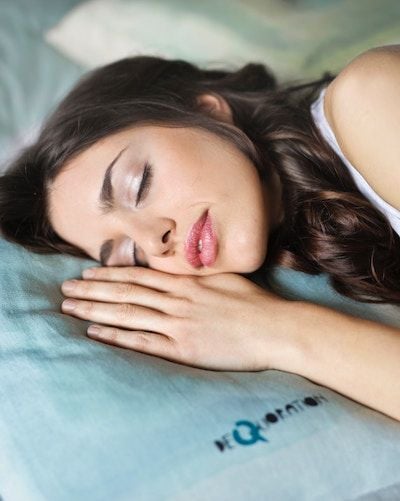![]() Written by Martin Reed, MEd, CHES®, CCSH.
Written by Martin Reed, MEd, CHES®, CCSH. ![]() Reviewed by .
Reviewed by .
What is stimulus control?
 Along with sleep restriction therapy, stimulus control is one of the main techniques used in a course of cognitive behavioral therapy for insomnia (CBT-I).
Along with sleep restriction therapy, stimulus control is one of the main techniques used in a course of cognitive behavioral therapy for insomnia (CBT-I).
The main goal of stimulus control is to strengthen the association between the bed and sleep.
For many people with insomnia, the bed is no longer a strong cue for sleep. When new clients enroll in my insomnia coaching course, many of them tell me that as bedtime approaches, they feel an ever-increasing level of anxiety.
This, of course, is far from ideal and does not encourage sleep! People with healthy sleep tend to look forward to bedtime and feel an ever-increasing level of relaxation as bedtime approaches.
This negative link with the bed and the bedroom has been learned due to nights of poor sleep, tossing and turning in bed all night, and feelings of frustration, worry, and even fear.
Since this link has been learned, a different link can be learned instead — and that is what stimulus control sets out to do.
Many insomniacs see their bed as an enemy and a place to fear. They see their beds as a place of wakefulness rather than sleep. Stimulus control corrects this by reducing the amount of time spent awake in bed and making sure that the bed is used only for sleep (and sex).
Over time, the link between the bed and sleep becomes re-learned. As the bed becomes a stronger cue for sleep and relaxation, sleep improves. As sleep improves, levels of fear, worry, and anxiety also fall — and this further improves sleep.
How does stimulus control work?
Stimulus control therapy for insomnia is evidence-based. This means that clinical studies have confirmed that the technique works.
Stimulus control works because of the power of association. Have you heard of classical conditioning? If not, perhaps you’ve heard of Pavlov’s experiments with dogs? Here’s a good overview of those experiments:
Pavlov’s dogs began to salivate as soon as they saw food because they learned that they were about to get fed. Next, the dogs began to salivate when they heard a sound that they learned to associate with getting fed. Pavlov soon learned that he could ‘condition’ the dogs to produce saliva by teaching them to associate getting fed with a range of different sounds and objects.
Of course, we are not dogs — but the theory is still sound!
When you were a child and you heard the ice-cream truck jingle, what happened? Your heart rate probably increased in anticipation of ice-cream. As an adult, if you get a speeding ticket you will probably notice your heart rate increase the next time you pass a police car on the road.
In other words, your body responds whenever you see or think about something that has triggered a body response in the past.
Here’s a good video about this:
When it comes to sleep, if you often spend a lot of time in bed awake, your body learns that the bed is a place to be awake. If you spend a lot of time in bed tossing, turning, and worrying, then your body learns that the bed is a place for tossing, turning, and worrying.
The solution, then, is to break this learned association. We do that by making sure the only thing we do in bed is sleep.
“But I can’t sleep!” I hear you say! OK, one step at a time! First, let’s teach the mind that the bed is for sleep. We do this by:
- Getting out of bed when we can’t sleep
- Not using the bed for anything other than sleep (or sex)
When should you get out of bed?
 If you are in bed, feel wide awake, and being awake in bed doesn’t feel good, stimulus control suggest getting out of bed until conditions feel better for sleep to occur.
If you are in bed, feel wide awake, and being awake in bed doesn’t feel good, stimulus control suggest getting out of bed until conditions feel better for sleep to occur.
During the time you are out of bed, you would do something that isn’t going to be too exciting or stimulating. A few suggestions:
- Read a book (a real book — no tablets, computers, or smartphones!)
- Do some household chores such as washing the dishes or ironing
- Do some light stretching
- Take a bath
If and when conditions feel better for sleep, get back into bed and, if you don’t fall asleep and wakefulness starts to feel really unpleasant again, repeat the process.
As you can probably imagine, this can lead to nights where you are impersonating a yo-yo, getting in and out of bed multiple times each night. This is why stimulus control for insomnia can be a real challenge to stick to. However:
Every time you get out of bed when you can’t sleep, you are teaching your mind that the bed is a place for sleep.
If you commit to this technique, over time your mind can learn that the bed is for sleep and not wakefulness.
Another benefit is that the time you spend awake and out of bed will help build sleep pressure, and this will make sleep more and more likely the longer you commit to the technique.
Save the bed for sleep and sex.
 Many people can list off a number of different things they do in bed. For example:
Many people can list off a number of different things they do in bed. For example:
- Reading
- Working
- Studying
- Watching TV
- Playing video games
- Finishing up work
When we do things other than sleep when we are in bed, we can teach ourselves that the bed is for activities other than sleep.
This becomes a problem for people with insomnia because they already have a strong association between the bed and wakefulness — and now they are adding another ‘strike’ against sleep by doing wakeful activities in bed.
Remember that the ultimate goal here is for the bed to be a trigger for sleep. Stimulus control suggests that we can only reach this goal if we use the bed for sleep and nothing else (other than sex).
Do not sleep anywhere other than the bed.
 Some of my clients tell me that they might sleep on the couch when watching TV before going to bed at night, or they fall asleep on the couch when they get out of bed during the night when practicing stimulus control.
Some of my clients tell me that they might sleep on the couch when watching TV before going to bed at night, or they fall asleep on the couch when they get out of bed during the night when practicing stimulus control.
This becomes a problem because when you sleep in a place other than the bed, you are creating an association between sleep and non-sleeping environments.
When you do this, you are not creating a strong association between sleep and your own bed — and this will make it harder to re-establish this connection.
It is important to make sure that the only place you sleep is your bed, or your normal (and intended) sleep environment.
You can’t relearn the association between your bed and sleep if you do not use your bed for sleep.
What are the effects of stimulus control?
 If you follow stimulus control in the right way, your mind will begin to link the bed with sleep and relaxation and your sleep may start to improve within a couple of weeks.
If you follow stimulus control in the right way, your mind will begin to link the bed with sleep and relaxation and your sleep may start to improve within a couple of weeks.
Stimulus control does not improve your sleep the very first time you try it!
I normally find that the longer my clients have been living with insomnia, the stronger the association they have made with the bed, wakefulness, and difficult emotions.
The stronger this learned association is, the longer it will normally take to break the association and retrain the mind so it associates the bed with sleep and relaxation.
(This is a good example of why it’s always better to address insomnia sooner rather than later.)
It’s also important to be aware that stimulus control might lead to less sleep in the short-term since you will be getting out of bed when you can’t sleep.
For this reason, it is important that you have plenty of support (in the form of an understanding partner and/or an experienced sleep coach).
Stimulus control summary.
 Stimulus control is a core part of cognitive behavioral therapy for insomnia (CBT-I).
Stimulus control is a core part of cognitive behavioral therapy for insomnia (CBT-I).
It is evidence-based, which means it has been clinically proven to be effective.
Stimulus control means only using the bed for sleep. The goal is to strengthen (or re-establish) the link between the bed and sleep and to weaken the learned association between the bed and activities other than sleep (including wakefulness, worry, fear, frustration, and anxiety).
Stimulus control can lead to sleep consolidation (better sleep efficiency).
As you strengthen the link between the bed and sleep, you will begin to spend more time in bed asleep. This will reduce sleep-related worry and anxiety — and this will lead to further improvements in your sleep.
For stimulus control to work, it needs to be followed correctly and consistently, night after night. This requires a lot of commitment (and support).
If you work with me as a client of Insomnia Coach, I will help you implement what I believe to be a more approachable alternative to stimulus control that doesn’t require getting out of bed (unless you wish to do so!) and that still helps you tackle any learned association between your bed and struggling with nighttime wakefulness.
Please rate this page
Share this page
Are you ready?
 If you enroll in my insomnia coaching course you will rediscover what it feels like to live a life independently of sleep.
If you enroll in my insomnia coaching course you will rediscover what it feels like to live a life independently of sleep.
You will move away from struggling with insomnia and all the difficult thoughts and feelings that often come with it.
Are you ready to move away from the endless and exhausting struggle?
Are you ready to get your life back from insomnia?
Not ready for the Insomnia Coach course just yet?
Get my free sleep training for insomnia course.
- Get 1 email every day for 2 weeks.
- Learn how to improve your sleep.
- Pay nothing (it’s free).
Over 10,000 people have taken the course and 98% would recommend it to a friend. Your email address will not be shared or sold. You can unsubscribe at any time. Privacy policy.



